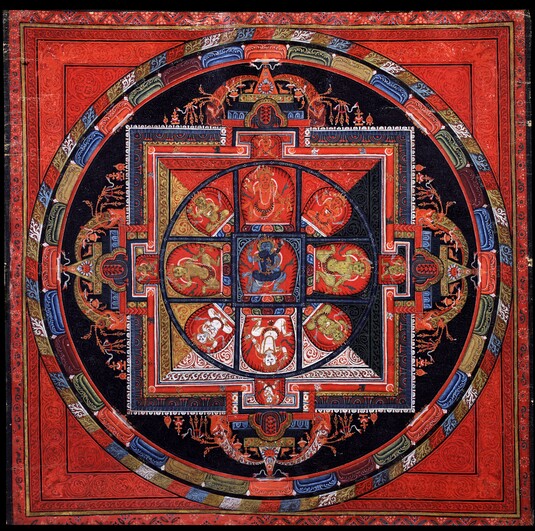
Item: Mandala of Achala (Buddhist Deity) - Chandamaharoshana (with consort)
| Origin Location | Central Tibet |
|---|---|
| Date Range | 1500 - 1599 |
| Lineages | Sakya and Ngor (Sakya) |
| Material | Ground Mineral Pigment, Fine Gold Line on Cotton |
| Collection | Carolyn and Wesley Halpert |
| Painting School | Ngor |
Classification: Deity
Appearance: Wrathful
Gender: Male
Chanda Maharoshana Nine Deity Mandala (Tibetan: tro wo tum po chen po mi yo wa lha gu kyil khor): from the Father (method) division of Anuttarayoga Tantra.
In the center of the mandala with one face and two hands, blue in colour, is the principle deity Chanda Maharoshana (also referred to as Achala). The right hand is upraised holding a flaming sword of wisdom and the left placed at the heart holds a vajra lasso and embraces the consort. In a kneeling posture with the right knee touching the ground and the left raised up he sits surrounded by the bright red flames of pristine awareness. The consort blue Mamaki embraces with both legs.
In the four directions surrounding the central pair are Red, Green, White and Yellow Achalas, in a similar posture, along with their consorts sitting at the intermediate directions, in relaxed postures. At the four doors, T shaped structures, are four door guardians. The square palace structure sits atop a giant double vajra serving as the ground, above a huge lotus blossom with the petals forming a ring. Outside of that is a circle of gold vajras followed by the five coloured flames of pristine awareness. The source text for this deity is the Shri Vajrachandachittaguhya tantra.
"...Lord Achala. The body is blue in colour, one face, two hands, the right brandishing to the sky a sword fiercely flaming with a mass of wisdom fire. And the left at the heart, in a wrathful gesture, holds a vajra lasso wound [around the index finger] with the ends hovering above the shoulder. With bared fangs, biting down on the lower lip, possessing three eyes, the right gazes upward completely eliminating heavenly daemons. The left gazes down, destroying nagas, spirits of disease and earth lords. The middle gazes forward completely eliminating all types of obstacles. Wearing a white snake as a necklace, gathering the power of nagas, spirits of disease and earth lords; with black hair, tied in a black tuft on the crown of the head; with jewel ornaments and various silks as a lower garment. The heel of the right foot and the left knee are pressing down on the seat in a manner of rising; dwelling in the center of a flaming mass of pristine awareness fire." (From a Tibetan text written by Ngorchen Konchog Lhundrub, 1497-1557. See Sanskrit source texts).
Jeff Watt 4-2000
Collection of Caroline & Wesley Halpert
Mandala: Mandala Main Page
Buddhist Deity: Achala Religious Context
Tradition: Sakya Deity Paintings
Buddhist Deity: Achala Main Page
Mandalas: Sakya Tradition
Buddhist Deity: Achala (Chandamaharoshana)
Buddhist Deity: Achala Masterworks (Painting)
Buddhist Deity: Achala, Chandamaharoshana
Buddhist Deity: Achala Source Texts
Mandala: Sakya Masterworks
Buddhist Deity: Achala (Mandala)
Mandala: Masterworks Page
Buddhist Deity: Achala Masterworks (Kneeling, Painting)
